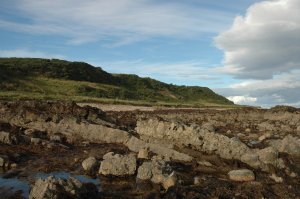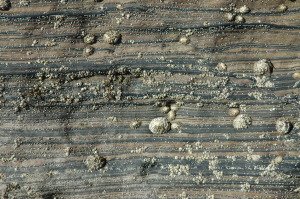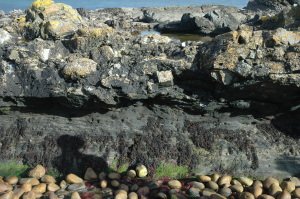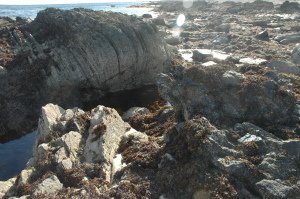Geologists love to play detectives. Often, we find rocks that just do not look right, that should’t be just that way, even may seem self contradicting. Enter our inner Sherlocks, when we find a geological mystery, we work until we find the answer and the guilty one. The guilty one is often a fault. I love faults.
We have a simple rule: If sedimentary rocks are fine grained, the sediments were transported far, ground to clay in the process, often deposited far into the sea. Only fine grained stuff can float there without sinking on the way. On the other hand, if the rock grains are coarse, they are close to the place they eroded from.
So, what to do if you have both?
That’s the way it is on the shoreline near Brora, on the Caithness peninsula, Scotland (or the Scottish part of still quite Great Britain, or what it is these days ;) ). On the shoreline – make sure to go at low tide – are rocks of Upper Jurassic age; more specifically Kimmeridgian in stratigraphish. The same age as the dirty, black shale that are source rocks for most of the British and Norwegian oil. Thick rock intervals at Brora actually are such source rocks; black, fine grained, paper thin. Some of them would burn if thrown into a fire, and they have nice imprints of ammonite fossils in them, along with belemnites; skeletons of elongate squids. In between are some interchanging beds of sand and shale, and then: Conglomerate, messy layers with big chunks of rock. Big, as in up to 15 meters long, chunks, which just roll down the underwater hill and stop at the base.

Green hills and a shoreline with coarse and fine sediment beds, near Brora, Scotland: Would you not love to do some field work here?

Art by nature: Thin interbedded sand and shale at Brora, decorated with more recent, round barnacles.
How came the short-travelled big boulders? The first clue, you can get from looking at a satellite image of Scotland on Gargle Maps: Ever wondered why Loch Ness is straight, long and thin as a super model? It lies along a huge fault zone, that stretches across Scotland, and developed in the Devonian period. When such a weakness zone is established, pulls and push on the Earth crust will continue to take place there, so this fault – The Great Glen Fault – has had many movements trough time. The shoreline at Brora lies along a splay, a sidetrack from the main fault. The fault plane is just a few hundred meters landwards – and, according to the geological map and da’ Big Excursion Leader, the other side consists of the same rock as the boulders: Devonian sandstones, called Flagstones, because they easily fracture along the beds into thin slabs.

Fine, black shale ready to boil for oil; and just above: A hodgepodge – or haggis? – of big Devonian Flagstone Boulders.
The elegant explanation is thus that, in the Upper Jurassic, the fault constituted a big, steep wall from land into the sea – so big that the upthrown side, the footwall – leaned slightly inwards, so most sediments eroded from the crest ran downwards to the land, rather than into the sea. Most of the time, the deep water along the steep coast received just fine grained sedimentation travelled from elsewhere, some occasional sand, and the deep, calm water was ideal to preserve organic matter that later could become oil. But, when the fault moved as the North Sea opened, earthquakes shaked big blocks loose and dumped them into the abyss, just like a talus slide in a valley, together with sand and gravel, and these later became the Boulder beds. Seismic data and oil well drillings confirm that the boulder beds only occur near the coast, and did not travel far from the fault.
So, if your manager is a geophysics smurf, who thinks that seismics and software from Hogwarts’ School of Geophysical Wizardry can tell everything you need before drill, baby, drill, then a long weekend field trip in Scotland may show otherwise. Actually, a field trip anywhere should be enough to convince that field work is necessary to understand reservoirs and petroleum systems. Sometimes you need to just go out and see how the geology looks in real life.
After all, not even Sherlock could solve a mystery without actually looking at the evidence.


